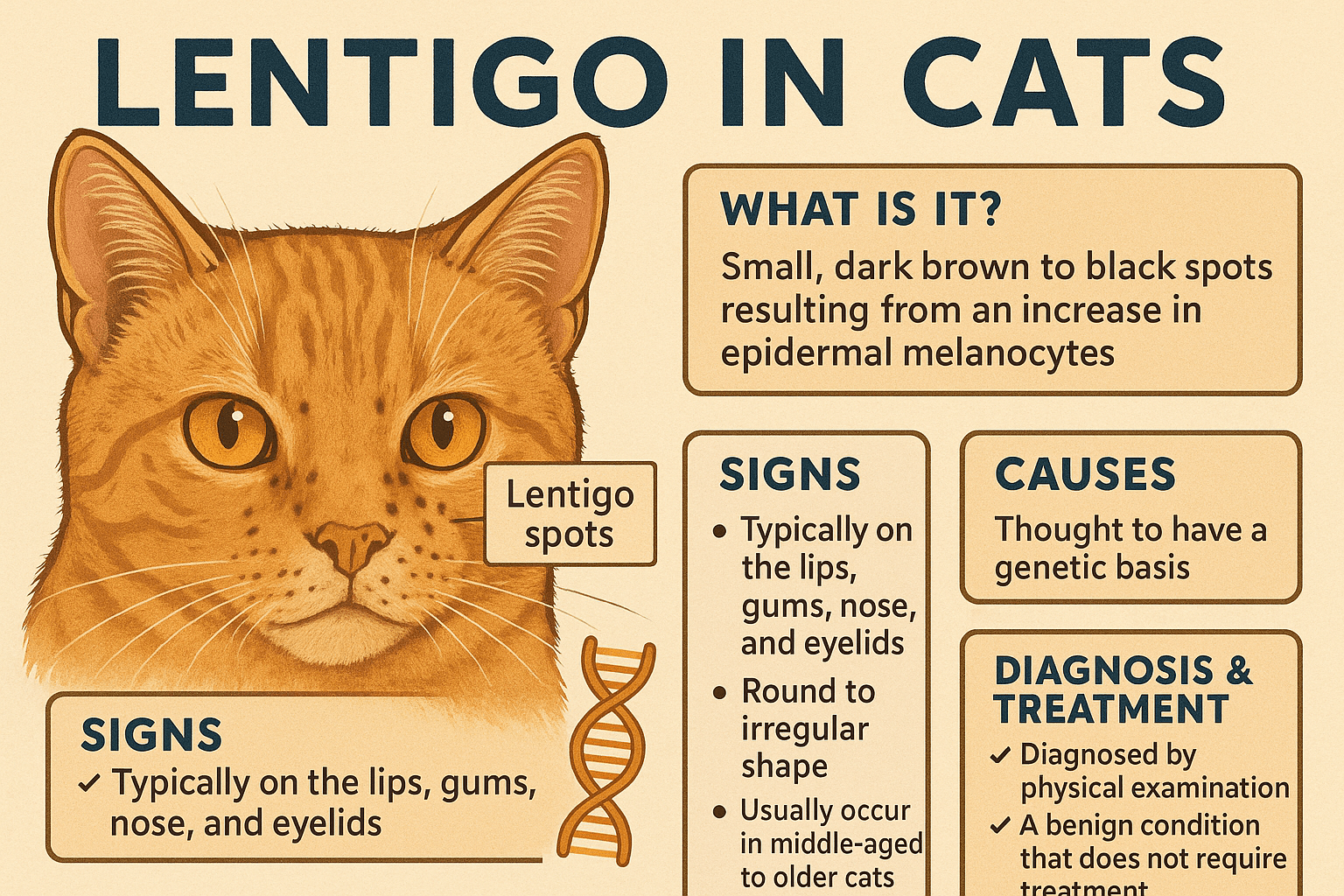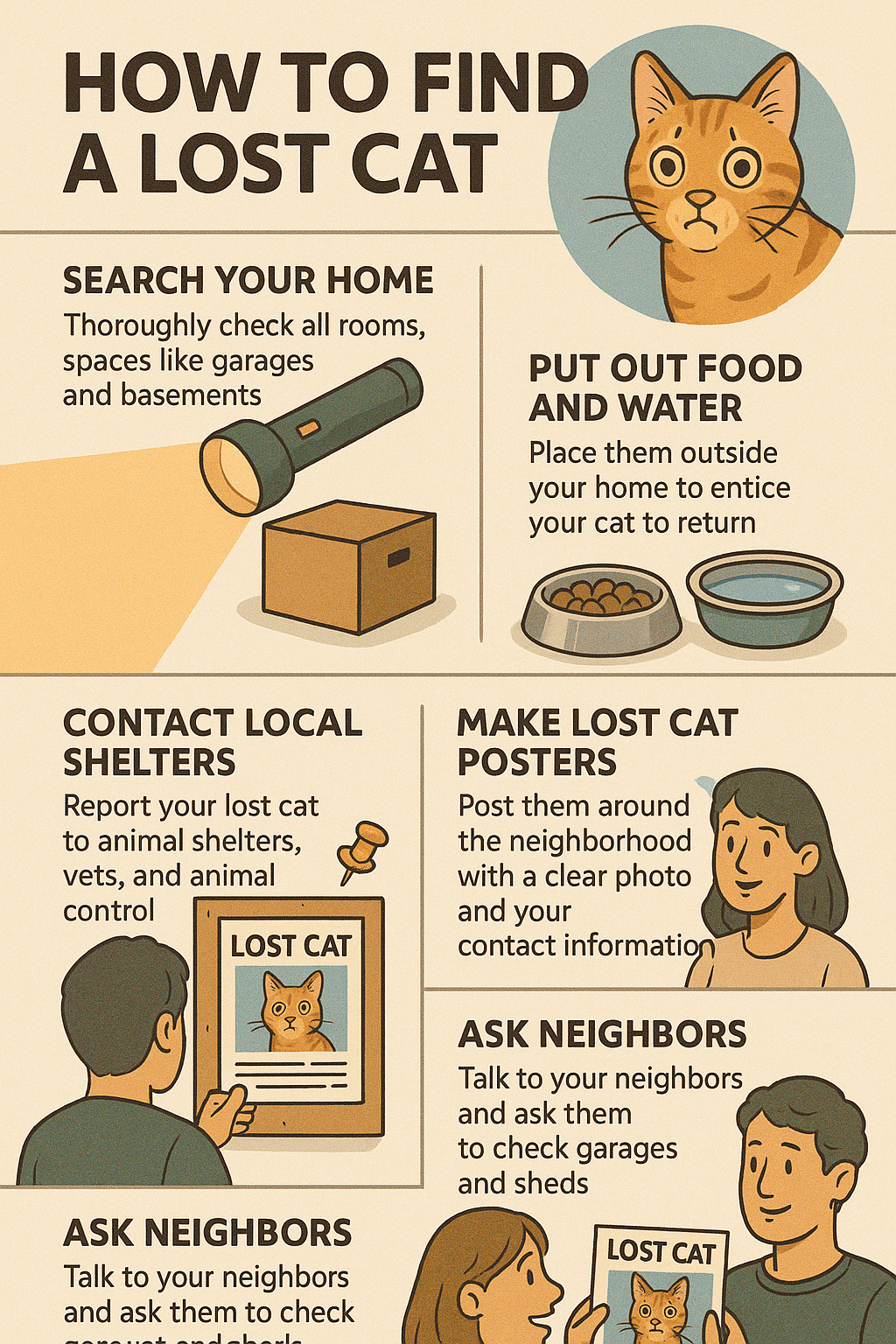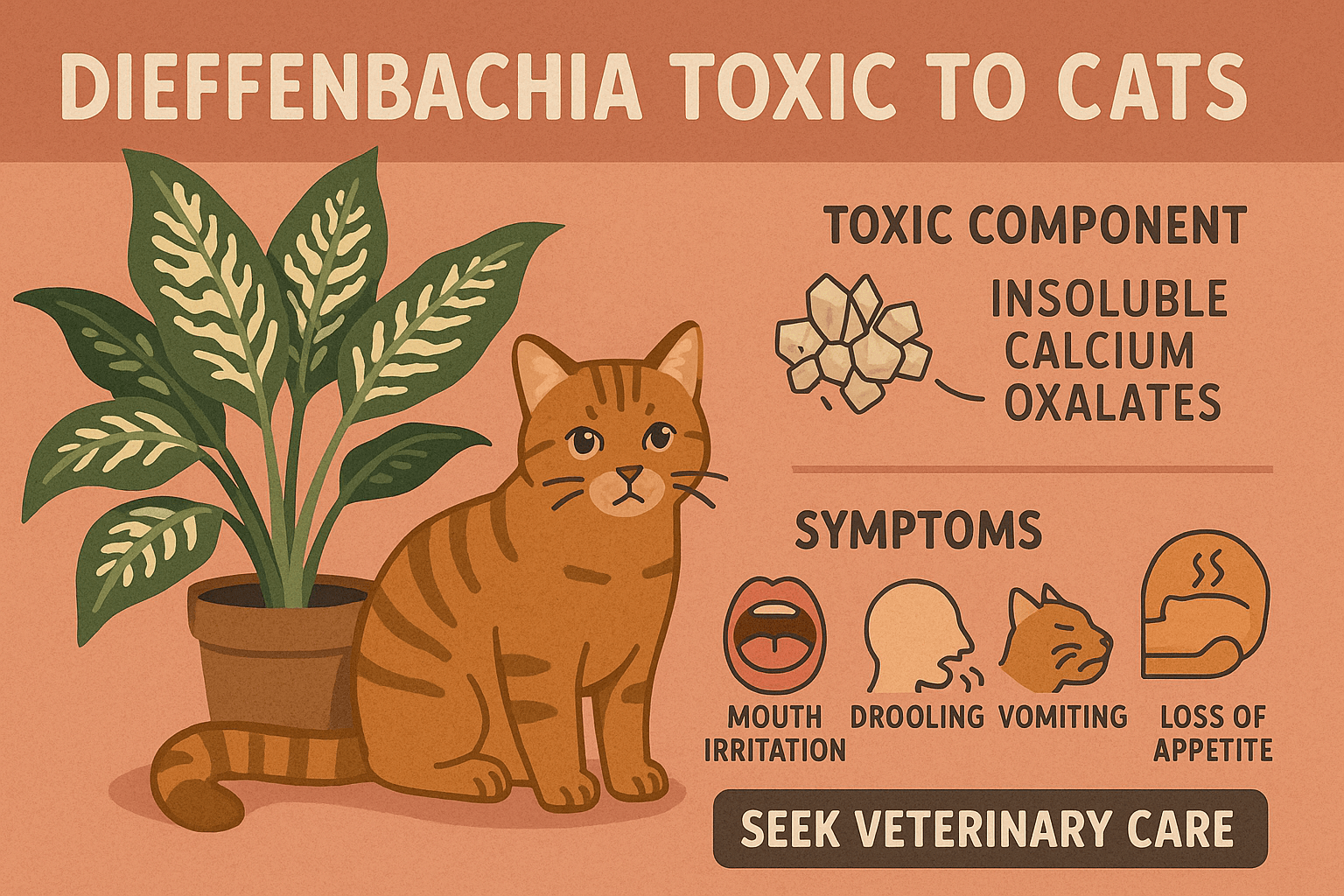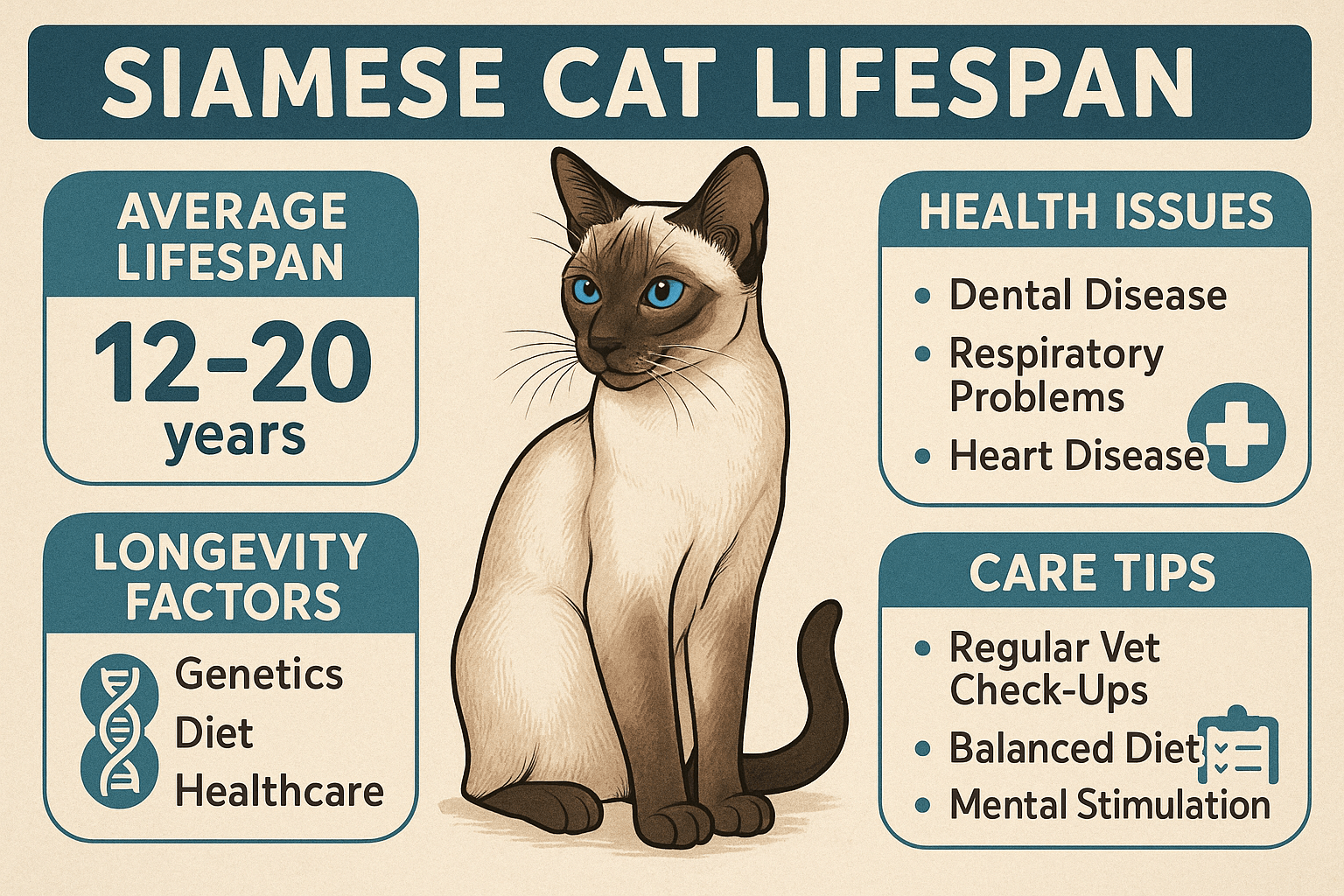Lentigo in Cats: What You Need to Know
If you’ve noticed small, dark spots appearing on your cat’s skin or lips, you might be wondering what they are and whether they’re cause for concern. These spots could be lentigo, a harmless condition often seen in cats, particularly those with lighter fur. While lentigo is generally benign, understanding its characteristics, causes, and implications can help you ensure your feline friend stays healthy and comfortable. In this blog post, we’ll explore everything about lentigo in cats—from identifying it to managing its appearance—so you can approach this topic with confidence and peace of mind.
What Is Lentigo in Cats?
Lentigo is a common and non-threatening skin condition that results in the development of small, pigmented spots on a cat’s skin. These spots are caused by an increase in melanin production and are typically found around areas like the lips, nose, or eyelids. Here’s what you need to know about lentigo in cats:
Appearance of Lentigo Spots:
Lentigo spots are flat, round, or irregularly shaped, and range in color from light brown to black. They often appear as freckles on cats’ skin.Common Locations:
These spots are most frequently seen around the lips, gums, nose, and sometimes the eyelids, especially in cats with pink or light-colored noses.Breed Predisposition:
Orange, cream, calico, and tortoiseshell cats are more prone to developing lentigo due to their genetic predisposition for increased pigmentation.Age Factor:
Lentigo typically develops in adult or senior cats, though younger cats may occasionally show signs of early pigmentation changes.Non-Cancerous Nature:
Unlike other skin conditions, lentigo is entirely benign and does not pose any health risks to your cat.
Understanding these key aspects of lentigo can help you identify it and differentiate it from more serious skin issues.
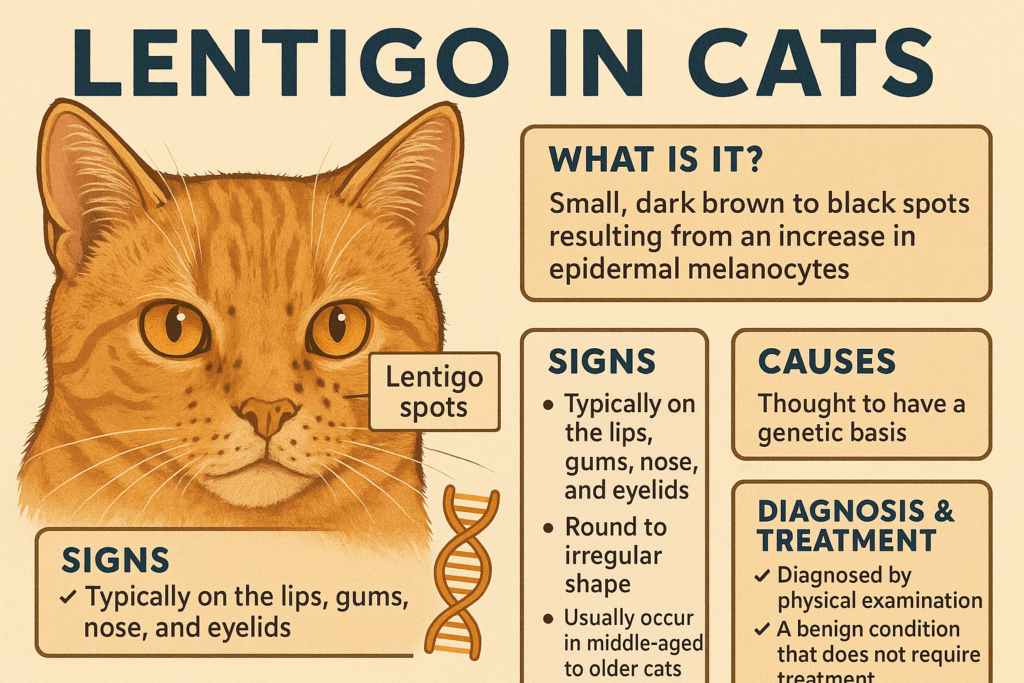
Signs and Symptoms of Lentigo in Cats
Recognizing lentigo in your cat involves observing specific physical changes. While the condition itself is harmless, being aware of its signs ensures you can monitor your cat’s health effectively.
Small, Freckle-Like Spots:
The hallmark of lentigo is the presence of tiny, dark spots that resemble freckles on your cat’s skin or mucous membranes.Gradual Appearance Over Time:
Lentigo spots tend to develop slowly, becoming more noticeable as your cat ages. They do not change rapidly in size or shape.Localized Pigmentation Changes:
The spots are usually concentrated in specific areas, such as the lips, nose, or gums, rather than spreading across the body.No Associated Pain or Discomfort:
Cats with lentigo do not experience itching, swelling, or discomfort related to the pigmented spots.Consistency in Color and Texture:
Lentigo spots remain flat and uniform in texture, distinguishing them from raised or irregular growths that may indicate other conditions.
By familiarizing yourself with these symptoms, you can confidently identify lentigo and rule out more concerning skin abnormalities.
Check this guide 👉Understanding Cat Skin Cancer: Best 7 Expert Tips!
Check this guide 👉Understanding Cat Skin Conditions: Best 7 Health Tips!
Check this guide 👉Dry Skin on Cats: Best 7 Expert Tips!
Characteristics of Lentigo | How to Differentiate from Other Conditions |
|---|---|
Flat, pigmented spots | Raised or ulcerated lesions may indicate cancer |
Common in orange or cream-colored cats | Rare in darker-coated cats |
Appears around lips, nose, or eyelids | Widespread spots may suggest systemic issues |
Develops gradually over time | Sudden changes in size or color are red flags |
No pain or irritation associated | Itching or swelling points to infections |
Causes of Lentigo in Cats
The exact cause of lentigo in cats is not fully understood, but several factors contribute to its development. Understanding these causes can provide clarity about why your cat may have developed these spots.
Genetic Predisposition:
Certain breeds and coat colors are more likely to develop lentigo due to inherited traits affecting melanin production.Aging Process:
As cats grow older, their bodies undergo natural changes, including increased pigmentation in localized areas.Sun Exposure:
Prolonged exposure to sunlight can stimulate melanin production, potentially contributing to the formation of lentigo spots.Hormonal Influences:
Hormonal fluctuations, particularly in aging cats, may play a role in the development of pigmented areas.Natural Variation in Skin Pigmentation:
Some cats simply have unique patterns of pigmentation that become more pronounced over time without any underlying issue.
While the causes vary, lentigo remains a harmless and purely cosmetic condition that requires no medical intervention.
Managing Lentigo in Cats
Although lentigo doesn’t require treatment, there are steps you can take to ensure your cat remains comfortable and healthy while living with this condition.
Regular Monitoring:
Keep an eye on the size, shape, and number of lentigo spots to detect any unusual changes that might warrant veterinary attention.Routine Vet Check-Ups:
Schedule annual or biannual visits to your veterinarian to rule out other potential skin conditions during routine exams.Minimize Sun Exposure:
Limit your cat’s time outdoors during peak sunlight hours to reduce the risk of excessive UV exposure, which could exacerbate pigmentation.Maintain Good Oral Hygiene:
If lentigo appears on your cat’s gums or lips, regular dental care can prevent secondary issues like gum disease or infections.Focus on Overall Health:
A balanced diet, proper hydration, and stress-free living contribute to your cat’s overall well-being, supporting healthy skin and coat.
By incorporating these practices into your cat’s care routine, you can manage lentigo effectively and maintain their quality of life.
Differentiating Lentigo from Other Skin Conditions
It’s important to distinguish lentigo from other skin issues to avoid unnecessary worry. Here’s how lentigo compares to similar conditions:
Flat vs. Raised Lesions:
Lentigo spots are always flat, whereas raised bumps could indicate tumors or cysts.Uniform Color Patterns:
Lentigo spots maintain consistent coloration, unlike melanoma, which may present varied hues.Localized Distribution:
Lentigo tends to cluster in specific areas, unlike systemic conditions that affect larger portions of the body.Absence of Symptoms:
Lentigo does not cause itching, redness, or inflammation, unlike allergic reactions or infections.Stable Growth Rate:
Lentigo spots grow slowly and predictably, unlike aggressive growths that expand rapidly.
Understanding these distinctions helps you identify lentigo accurately and seek professional advice when needed.
Caring for Senior Cats with Lentigo
Senior cats are more likely to develop lentigo, making it essential to focus on their overall well-being. Here are some tips for caring for older cats with this condition:
Monitor Skin Health Regularly:
Check your senior cat’s skin weekly for any unusual changes beyond lentigo spots.Prioritize Nutrition:
Provide a nutrient-rich diet tailored to senior cats to support their immune system and skin health.Encourage Gentle Exercise:
Low-impact activities keep senior cats active and promote circulation, benefiting their skin and coat.Enhance Comfort Indoors:
Create a cozy indoor environment to minimize stress and protect their delicate skin from harsh elements.Schedule Frequent Vet Visits:
Older cats benefit from more frequent check-ups to catch age-related issues early.
With attentive care, senior cats with lentigo can enjoy a happy and fulfilling life.
Myths and Misconceptions About Lentigo
Several myths surround lentigo in cats, leading to confusion among pet owners. Let’s debunk some common misconceptions:
Myth: Lentigo Indicates Cancer Risk:
Fact: Lentigo is completely benign and unrelated to cancerous growths.Myth: Lentigo Requires Treatment:
Fact: Lentigo needs no treatment unless complications arise, which is rare.Myth: Only Outdoor Cats Develop Lentigo:
Fact: Indoor cats are equally susceptible to lentigo, though outdoor cats may face additional sun exposure risks.Myth: Lentigo Spots Can Be Removed Easily:
Fact: Removing lentigo spots is unnecessary and invasive, as they pose no harm.Myth: Lentigo Is Contagious:
Fact: Lentigo is not contagious and cannot be transmitted between animals or humans.
Dispelling these myths fosters a better understanding of lentigo and reduces unnecessary anxiety.
Frequently Asked Questions About Lentigo in Cats
Is lentigo dangerous for my cat?
No, lentigo is a harmless condition that poses no health risks to your cat.
Can lentigo spread to other parts of the body?
Lentigo typically remains localized to specific areas like the lips, nose, or eyelids and does not spread extensively.
Should I be concerned if new spots appear?
New spots are normal as your cat ages, but consult your vet if the spots change rapidly in size, shape, or color.
Does lentigo affect all cat breeds equally?
No, orange, cream, calico, and tortoiseshell cats are more likely to develop lentigo due to their genetics.
Can I prevent lentigo in my cat?
Lentigo cannot be prevented, but minimizing sun exposure and maintaining good health can reduce its progression.
Embracing Lentigo as a Natural Part of Your Cat’s Life
Lentigo in cats is a fascinating and harmless phenomenon that adds character to your feline companion’s unique appearance. While it may raise questions initially, understanding its nature, causes, and management can ease any worries you might have. By staying vigilant and providing proper care, you can ensure your cat remains happy and healthy despite these little freckles. Remember, lentigo is just one of the many quirks that make your cat special—a testament to their individuality and charm.
How to Find a Lost Cat: Best 7 Expert Tips! Discover actionable strategies to locate your missing cat, understand their behavior, and prevent future escapes with expert advice.
Is Dieffenbachia Toxic to Cats? Best 7 Expert Tips! Discover the dangers of Dieffenbachia, symptoms of poisoning, and how to keep your cat safe with expert advice and preventive measures.
Lentigo in Cats: Best 7 Expert Tips! Discover expert advice on understanding, identifying, and managing lentigo in cats to ensure your feline's health and happiness.
Siamese Cat Lifespan: Best 7 Expert Tips! Discover how to maximize your Siamese cat’s longevity with expert advice on health, care, and lifestyle for a happy, thriving feline companion.

